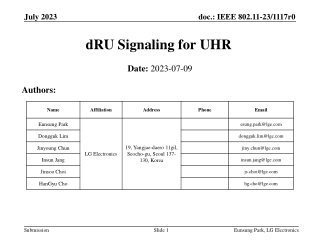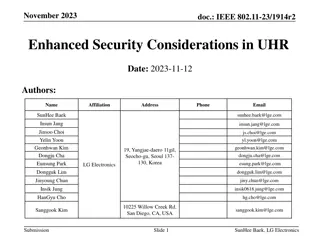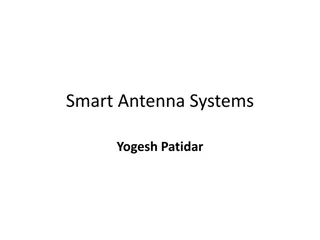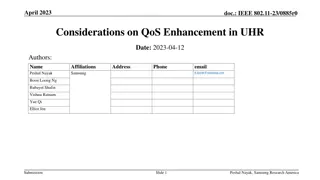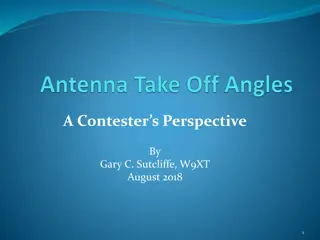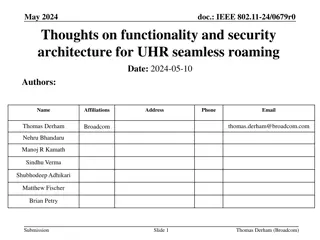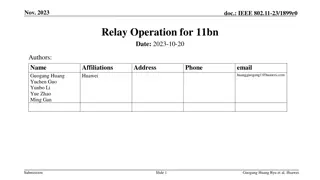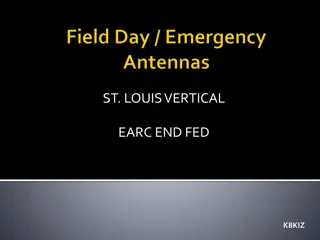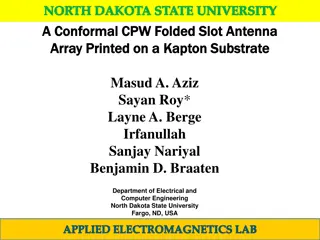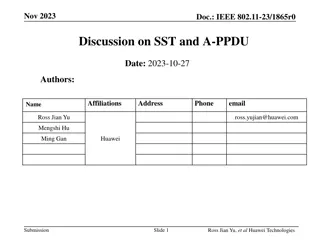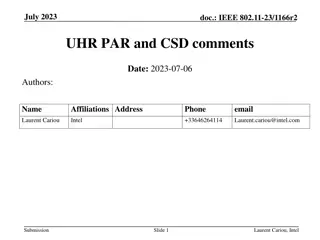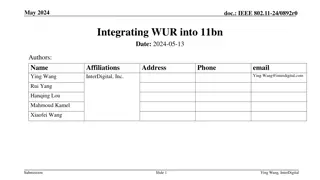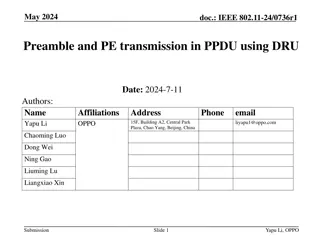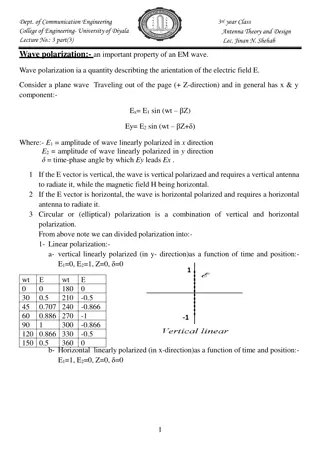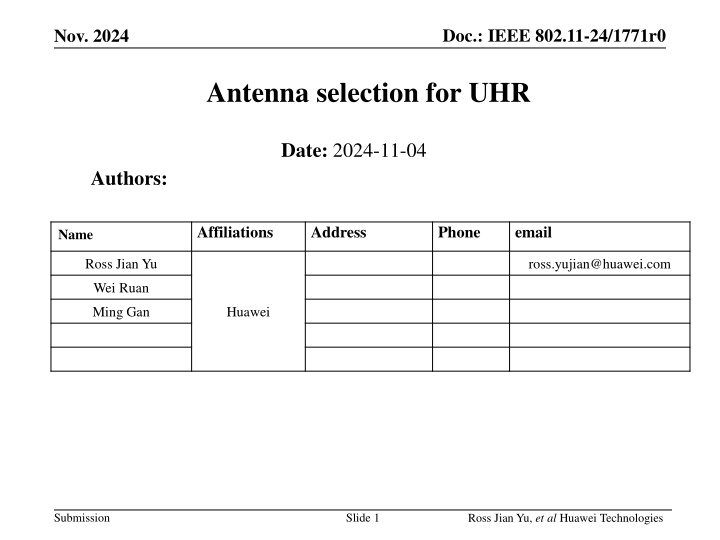
Antenna Selection for Ultra High Rate in Wireless Networks
"Explore antenna selection strategies for Ultra High Rate (UHR) in wireless networks, focusing on smart antennas and their benefits like improved coverage, throughput, and reliability. The document discusses antenna array configurations, 11n and 11bn antenna selection procedures, and proposed Tx/Rx antenna selection approaches for enhanced performance."
Download Presentation

Please find below an Image/Link to download the presentation.
The content on the website is provided AS IS for your information and personal use only. It may not be sold, licensed, or shared on other websites without obtaining consent from the author. If you encounter any issues during the download, it is possible that the publisher has removed the file from their server.
You are allowed to download the files provided on this website for personal or commercial use, subject to the condition that they are used lawfully. All files are the property of their respective owners.
The content on the website is provided AS IS for your information and personal use only. It may not be sold, licensed, or shared on other websites without obtaining consent from the author.
E N D
Presentation Transcript
Doc.: IEEE 802.11-24/1771r0 Nov. 2024 Antenna selection for UHR Date: 2024-11-04 Authors: Affiliations Address Phone email Name Ross Jian Yu ross.yujian@huawei.com Wei Ruan Ming Gan Huawei Submission Slide 1 Ross Jian Yu, et al Huawei Technologies
Doc.: IEEE 802.11-24/1771r0 Nov. 2024 Introduction Smart antennas have been widely used in Wi-Fi networks to provide the following benefits [1]: Better coverage Higher throughput Higher reliability This aligns very well with UHR PAR. An antenna array is made up of a series of small antennas. Each small antenna can be an omnidirectional antenna or a directional antenna. One example is shown as follows [1]. Submission Slide 2 Ross Jian Yu, et al Huawei Technologies
Doc.: IEEE 802.11-24/1771r0 Nov. 2024 Antenna selection in 11n 802.11n defines antenna selection procedure that supports up to eight antennas and up to four RF chains. TXASSI: transmit antenna selection sounding indication TXASSR: transmit antenna selection sounding request RXASSI: receive antenna selection sounding indication RXASSR: receive antenna selection sounding request ASEL: antenna selection Consecutive Sounding PPDUs +HTC frame with NDPA = 1 SIFS SIFS NDP NDP TXASSI or ... TXASSI TXASSI Transmit ASEL SIFS Segmented sounding PPDU Segmented sounding PPDU ASEL Transmitter TXASSR (Optional) ASEL Responder ASEL Feedback Consecutive Sounding PPDUs Channel reciprocity +HTC frame with NDPA = 1 SIFS SIFS NDP NDP RXASSI Receive ASEL ASEL Sounding Capable Transmitter or ... RXASSI RXASSI SIFS Segmented sounding PPDU Segmented sounding PPDU RXASSR (Optional) ASEL Responder Submission Slide 3 Ross Jian Yu, et al Huawei Technologies
Doc.: IEEE 802.11-24/1771r0 Nov. 2024 Antenna selection in 11n 11n ASEL procedure only applies only to HT and non-HT PPDUs. With smart antennas applied more widely on WLAN devices, including both APs and non-AP STAs (e.g., high-end mobile phones), it is beneficial to extend 11n ASEL to 11bn. For 11bn, we intend to design the procedure based on 11n procedure to simplify the procedure. Submission Slide 4 Ross Jian Yu, et al Huawei Technologies
Doc.: IEEE 802.11-24/1771r0 Nov. 2024 Proposed Tx antenna selection for 11bn The proposed transmit antenna selection procedure is as follows. UHR sounding PPDU UHR sounding PPDU UHR sounding PPDU UHR NDPA SIFS SIFS SIFS SIFS SIFS ... AP ASEL Feedback Non-AP STA1 TXASSR (Optional) The procedure can be extended to trigger based procedure to enable Tx ASEL with multiple STAs. UHR sounding PPDU UHR sounding PPDU UHR sounding PPDU BFRP Trigger SIFS Trigger UHR NDPA SIFS SIFS SIFS SIFS SIFS SIFS ... AP Optional ASEL Feedback Non-AP STA1 TXASSR ASEL Feedback Non-AP STA2 TXASSR ASEL Feedback Non-AP STA3 TXASSR Submission Slide 5 Ross Jian Yu, et al Huawei Technologies
Doc.: IEEE 802.11-24/1771r0 Nov. 2024 Proposed Rx antenna selection for 11bn The proposed receive antenna selection procedure is as follows. RXASSR (optional) AP UHR sounding PPDU UHR sounding PPDU UHR sounding PPDU UHR NDPA SIFS SIFS SIFS SIFS ... Non-AP STA1 The procedure can be extended to trigger based procedure to enable Rx ASEL with multiple STAs. Trigger/UHR NDPA AP UHR sounding PPDU UHR sounding PPDU UHR sounding PPDU SIFS SIFS SIFS ... Non-AP STA1 UHR sounding PPDU UHR sounding PPDU UHR sounding PPDU SIFS SIFS SIFS Non-AP STA2 ... Submission Slide 6 Ross Jian Yu, et al Huawei Technologies
Doc.: IEEE 802.11-24/1771r0 Nov. 2024 ASEL signaling in 802.11n The ASEL signaling is carried in HT variant of HT control field. Details info of ASEL Command and ASEL Data can be found in the appendix. 1 29 1 1 Bits AC RDG/More PPDU VHT HT Control middle Constraint 15 2 2 2 4 1 Bits 2 1 Link HT NDP Announceme nt Calibration Position Calibration Sequence DEI Adaptation Control Reserved CSI/Steering Reserved Bits 1 4 3 7 TRQ MAI MFSI MFB/ASELC 3 4 ASEL Command ASEL Data Submission Slide 7 Ross Jian Yu, et al Huawei Technologies
Doc.: IEEE 802.11-24/1771r0 Nov. 2024 ASEL signaling in 802.11bn For 802.11bn, the related signaling can be in NDPA frame, A-control subfield, and UHR-SIG field of a UHR sounding PPDU. Details can be further discussed. Submission Slide 8 Ross Jian Yu, et al Huawei Technologies
Doc.: IEEE 802.11-24/1771r0 Nov. 2024 Summary In this contribution, we propose to enable ASEL in 802.11bn. Details can be further discussed. Submission Slide 9 Ross Jian Yu, et al Huawei Technologies
Doc.: IEEE 802.11-24/1771r0 Nov. 2024 Reference 1. https://e.huawei.com/en/material/networking/wlan/f5fc602b529944c09f61e 51492a20216 2. IEEE P802.11 Revme D7.0 Submission Slide 10 Ross Jian Yu, et al Huawei Technologies
Doc.: IEEE 802.11-24/1771r0 Nov. 2024 Appendix Table 9-20 ASEL Command and ASEL Data subfields ASEL Command Interpretation of ASEL Command ASEL Data 0 Transmit Antenna Selection Sounding Indication (TXASSI) Number of remaining sounding PPDUs to be transmitted See NOTE 1 Transmit Antenna Selection Sounding Request (TXASSR) or Transmit ASEL Sounding Resumption 0 when the command is Transmit ASEL Sounding Request A number in the range 1 to 15, the number being the number of the first sounding PPDU to be transmitted when the command is Transmit ASEL Sounding Resumption, where 0 corresponds to the first sounding PPDU in the original ASEL training sequence 2 Receive Antenna Selection Sounding Indication (RXASSI) Number of remaining sounding PPDUs to be received See NOTE 3 Receive Antenna Selection Sounding Request (RXASSR) Number of sounding PPDUs required 4 Sounding Label Sequence number of the sounding PPDU corresponding to a channel state information (CSI) frame in ASEL feedback 5 No Feedback Due to ASEL Training Failure or Stale Feedback The number of the first sounding PPDU that was not received properly, where 0 corresponds to the first sounding PPDU in the ASEL training sequence, or 0 if no sounding PPDUs were received properly, or 0 if this is a request for a full retraining sequence 6 Transmit Antenna Selection Sounding Indication requesting feedback of explicit CSI (TXASSI-CSI) Number of remaining sounding PPDUs to be transmitted See NOTE Submission Slide 11 Ross Jian Yu, et al Huawei Technologies 7 Reserved Reserved

